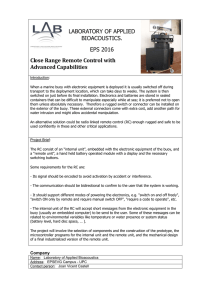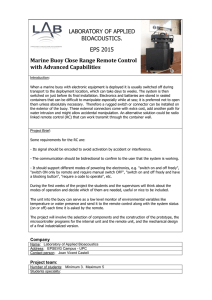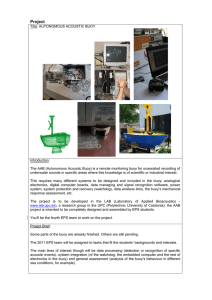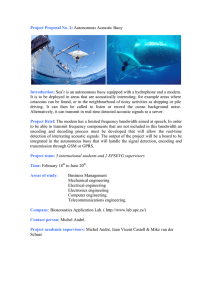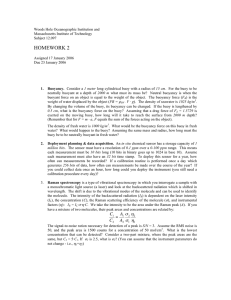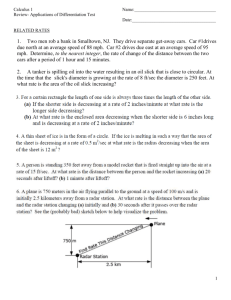Oxybuoy: Constructing a Real-Time Inexpensive Hypoxia Monitoring Platform
advertisement
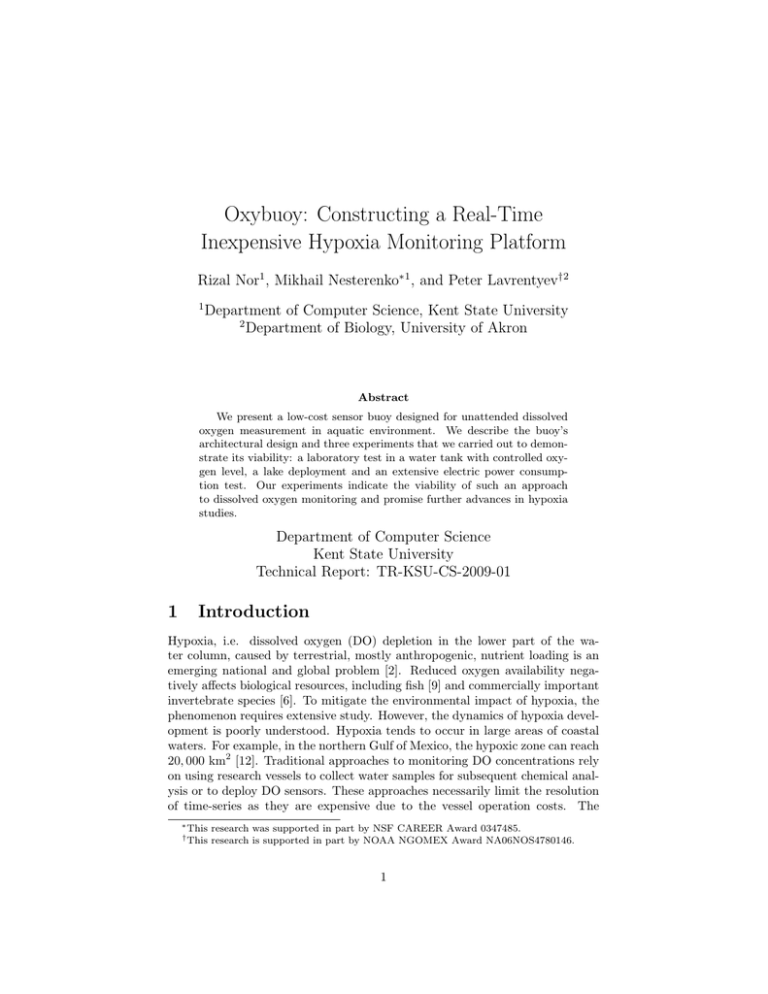
Oxybuoy: Constructing a Real-Time Inexpensive Hypoxia Monitoring Platform Rizal Nor1 , Mikhail Nesterenko∗1 , and Peter Lavrentyev†2 1 Department of Computer Science, Kent State University 2 Department of Biology, University of Akron Abstract We present a low-cost sensor buoy designed for unattended dissolved oxygen measurement in aquatic environment. We describe the buoy’s architectural design and three experiments that we carried out to demonstrate its viability: a laboratory test in a water tank with controlled oxygen level, a lake deployment and an extensive electric power consumption test. Our experiments indicate the viability of such an approach to dissolved oxygen monitoring and promise further advances in hypoxia studies. Department of Computer Science Kent State University Technical Report: TR-KSU-CS-2009-01 1 Introduction Hypoxia, i.e. dissolved oxygen (DO) depletion in the lower part of the water column, caused by terrestrial, mostly anthropogenic, nutrient loading is an emerging national and global problem [2]. Reduced oxygen availability negatively affects biological resources, including fish [9] and commercially important invertebrate species [6]. To mitigate the environmental impact of hypoxia, the phenomenon requires extensive study. However, the dynamics of hypoxia development is poorly understood. Hypoxia tends to occur in large areas of coastal waters. For example, in the northern Gulf of Mexico, the hypoxic zone can reach 20, 000 km2 [12]. Traditional approaches to monitoring DO concentrations rely on using research vessels to collect water samples for subsequent chemical analysis or to deploy DO sensors. These approaches necessarily limit the resolution of time-series as they are expensive due to the vessel operation costs. The ∗ This † This research was supported in part by NSF CAREER Award 0347485. research is supported in part by NOAA NGOMEX Award NA06NOS4780146. 1 measurements are weather-dependent as the ship DO sampling gear cannot be operated in rough seas. Moreover, with a single ship, it is impossible to measure DO concentration in several diverse locations simultaneously. The lack of data that can match the scale of the phenomena hinders hypoxia modeling efforts. Remote sensing is commonly used in large-scale oceanographic studies. For example, Pearce and Pattiaratchi [7] discuss various satellite image processing techniques to determine sea-surface temperature, surface chlorophyll distribution and ocean’s currents. However, satellite data require ground truthing and are limited to the ocean surface, whereas hypoxia develops in bottom waters. Unlike sea temperature and phytoplankton photopigments, DO does not have a proxy suitable for remote observations. Relationships between satellitemeasured chlorophyll and hypoxia are confounded by the interaction of physical processes with the seasonal cycle of nutrient-enhanced productivity [12]. The limitations of traditional approaches stress the need for new high-resolution real-time monitoring tools. An unattended buoy system becomes an attractive option. An array of such buoys deployed in coastal areas can record the DO concentration around the clock at multiple locations simultaneously and relay the data to the researcher. The technical requirements for such a buoy are as follows. A buoy needs to be capable of independent operation for up to four months – the time hypoxia occurs. It needs to be positioned 10 to 40 miles offshore and capable of sensing DO at depths of up to 50 meters. Four to six times per day sampling rate is acceptable. All these parameters are well within what present-day technology allows. However, the market for such buoys is so small that the commercial companies have to charge large premiums to recoup their development costs. Another commercial strategy is to develop a sensor platform that could be used for a variety of studies. Such platform tends to contain features that are not necessary for hypoxia study. Both approaches push the price of a commercial buoy outside the price range where extensive hypoxia studies become feasible. Meanwhile, advances in consumer electronics and sensor technology enable such buoy construction from commercial off-the-shelf components at costs that make large hypoxia studies practical. In this paper we describe the design and testing of Oxybuoy — a proof of concept buoy for hypoxia studies. The total cost of the buoy is around $5, 000 Related work. Gobat et al. [3] report on the development of an extensive military meteorological buoy systems. Guinasso et al. [4] and Bender et al. [5] describe a series of large buoy deployments for surface current measurements. Wallinga et al. [13] describe a buoy platform that can accommodate up to 100 sensors. This is a large-size buoy which requires solar batteries to power the equipment. Blain et al.[8] describe the design of a DO sensor MAREL buoy. The design was done using a membrane-based DO sensor. Such sensors are sensitive to bio-fouling and long-term measurement drift. The buoy contains a system of bio-fouling prevention that involves pumping the water from the desired depth to the surface for measurement, then automatic periodic flushing of the sensor with an anti-bacterial chlorinated solution. There is also the need 2 for extensive sensor calibration to account for measurement drift. The data was transmitted from the MAREL buoy to shore using wireless LAN technology. Voigt et al. [11] describe their experiences building an array of temperaturemeasuring buoys connected by a wireless LAN. In their position paper, Akyildiz et al. [1] describe the challenges of gathering sensor data in the marine environment. Wood et all [14] describe a design of a self-propelled float or a canoe that can follow a certain route and en route lower the sensor with a winch to a desired depth and take measurements. Another automated sensor gathering system is described by Vasilescu et al [10]. It involves robotic submarine, optical and acoustic communication, etc. These designs may be too expensive and complicated for the kind of hypoxia studies we anticipate. The rest of the paper is organized as follows. We discuss Oxybuoy architecture in Section 2. In Section 3 we describe our experiments with the buoy deployment. In the last section we outline our future plans. 2 Oxybuoy Architecture Design decisions. Our design decisions were dictated by the hypoxia studies requirements and the need to keep the buoy cost as low as possible. We used an optical oxygen sensor. This type of DO sensor, although relatively expensive, has fewer problems with bio-fouling and loss of calibration than the commonly used membrane-based DO sensors. There is a relatively limited amount of data to be collected during DO monitoring. Coupled with low sampling rate, it allowed us to use simple sealed batteries and avoid having to install solar panels. Let us discuss our buoy communication decisions. Oxybuoy needs to be deployed in such distances from the shore that cellular networks are not reachable. Wireless communication at such distances requires high masts and other design options that would make the cost of the buoy prohibitively expensive. However, due to the limited data rate, we are able to use commercial satellite network for data transmission. Architecture description. The Oxybuoy electronics contains the following main components: Gumstix PXA270 processor embedded system, PIC12F683 Microcontroller, 9601-D-N Satellite Modem, RS232 to SDI Converter, Marvell 88W8385 802.11(b and g) wireless card, D-OPTO optical sensor, switching relay and a switching voltage regulator. Oxybuoy architecture diagram is shown in Figure 1. The main data processing and control over the other devices is carried out by the Gumstix embedded system. Two Gigabyte SD flash card connected to the Gumstix provides data storage for the system. The optical sensor is controlled through SDI-12 sensor communication standard. To connect the sensor to the Gumstix we use RS232 to SDI-12 converter. The satellite modem is connected directly to one of Gumstix serial ports. The 3 Figure 1: Oxybuoy architecture diagram. wireless card allows backup and debugging communication channel to the system. The PIC processor is used to implement the low-power operation of the system. Gumstix and PIC processors complement each other. Gumstix provides flexible user and programmer interface and ease of data storage and retrieval while PIC has low power consumption. Electric power design. There are two modes of the system operation: active sampling mode and power saving sleep mode. In the active sampling mode the system draws about 350 mA, while in the sleep mode the system draws only 11 mA. During the sleep mode only the PIC is powered up. The PIC has 1024bit ADC connection to the battery. It is capable of reading the voltage level there. This information is helpful in determining the remaining charge left in the battery. The PIC is programmed to turn on the system to the active sampling mode. It then sends the current battery voltage level to the Gumstix processor and waits for a 2-bit signal from it to indicate the sleep period. After receiving this signal, the PIC powers down the remainder of the system. Most of the system components require reliable 5V DC power. The DO sensor requires 8V power. We use a 5V 1A Switching voltage regulator to provide stable voltage to the system. This regulator has conversion efficiency of up to 90% which helps to minimize power consumption. Programming and operation. Gumstix runs Open Embedded, a flavor of Linux for embedded systems. Programs and scripts are written and loaded into Open Embedded to handle communication between devices and system 4 maintenance tasks. The system operation is as follows. When Gumstix is powered up, it receives the ADC battery power level data from the PIC processor. Then Gumstix communicates through the RS232 serial connector to the SDI-12 converter to request a reading from the DO sensor. After collecting the data, Gumstix requests the satellite modem to transmit the data to the base station. During satellite communication, the Gumstix checks the signal strength indicator. If it is too low, the data is saved on the SD card and transmitted during the next communication session. After satellite communication, the Gumstix issues the command to the PIC informing it of the sampling rate and instructing it to power down the system. During its uptime Gumstix powers up the wireless card and remains accessible over wireless for status checks and configuration updates. Gumstix is programmed to receive control commands from the satellite. In particular the sampling rate can be changed remotely. 3 Experiments This section describes the series of experiments that we carried out to determine the viability and performance of Oxybuoy. In the first experiment we used a controlled laboratory environment to check the operation of the Oxybuoy’s electronics. In the second we performed a test deployment in a small lake. In the third experiment we ran an extended power usage measurements. During the experiments, the buoy was powered by 12V DC 7Ah sealed battery. Figure 2: Packaging of Oxybuoy electronics for the DO lab experiment. Controlled DO lab experiment. The objective of this experiment was to 5 test the operation of the electronics of Oxybuoy in the controlled environment. We used a water tank in a fish physiology laboratory at the University of Akron equipped for hypoxia experiments. The DO concentration in the tank was maintained at a specific level. The tank had external thermometer and YSI DO meter. Before the experiment we calibrated our DO sensor according to the manufacturer instructions. 26.15 26.1 temperature, C 26.05 26 25.95 25.9 25.85 0 10 20 30 40 time, hours 50 60 70 80 60 70 80 (a) Temperature readings. 2.5 2 oxygen concentration, ppm 1.5 1 0.5 0 -0.5 -1 0 10 20 30 40 time, hours 50 (b) DO concentration readings. Figure 3: Oxybuoy measurements in the DO lab experiment. The electronic components were wall-powered. No protective packaging was used (see Figure 2). Only the DO sensor itself was submerged. We configured Oxybuoy to use the wireless card to report the measurements every 20 minutes to the wireless bridge and on to the server where the information was collected. The DO and temperature data are shown in Figure 3. The oscillation of temperature and DO concentration level are due to the design of the tank system: periodically 6 a motor pumps fresh water into the tank. The temperature readings agree with the external meter measurements precisely while the DO concentration measurements agree with them approximately. (a) Electronics packaging of Oxybuoy. (b) Oxybuoy ready for assembly before deployment. Figure 4: Lake deployment experiment. Bath Lake deployment. The objective of this experiment was to test the complete operation of Oxybuoy in the target environment. We deployed the buoy in Bath Lake, a small eutrophuc lake within the Bath Nature Preserve near Akron, Ohio for 7 days. To protect the electronics from water exposure we put more effort into buoy packaging. The buoy packaging in shown in Figure 4. We used 6” PVC pipe for the outer shell. For the electronics container we used a simple poster carrier pipe. The outer pipe housed the electronics, ballast and the battery. The buoy was attached by a chain to a single anchor point. The outer shell was hermetically sealed at the bottom. The oxygen sensor, and the satellite antenna cables were fed through the silicone-sealed hole in the screw-on pipe cover. This way all the possible orifices are above water. After the weeklong deployment the design proved generally sound. Although, some moisture permeated the outer shell, the electronics were not damaged. The weight of the ballast had to be carefully calculated. We wanted to ensure that the buoy is submerged deep enough in the water so that it is stable yet the the buoy cover with the instrument and antenna openings are high enough about water level to prevent continuous contact with it. We computed the weight of the ballast to have the buoy submerged about three-fourths in the water. The calculation is based on the amount water the buoy displaces, and hence the amount of buoyancy it provides. 7 19 18 17 temperature, C 16 15 14 13 12 11 10 9 0 5 10 15 20 25 20 25 time, hours (a) Temperature readings. 12 oxygen concentration, ppm 10 8 6 4 2 0 0 5 10 15 time, hours (b) DO concentration readings. Figure 5: Oxybuoy measurements in the lake deployment experiment. We first tested the seal of the outer shell in a separate short deployment. Before the main deployment we tested the operation of the electronic components through first wireless connection then through the satellite messages. During the deployment we did not use the multi-mode operation due to interference with DO sensor measurements. We used active sampling mode only and allowed the buoy to run until the battery charge was exhausted. During the deployment, Oxybuoy reported DO measurements 6 times per hour. Running in this mode, Oxybuoy remained operational and reported DO measurements for over 18 hours. The measurements are shown in Figure 5. For testing purposes Oxybuoy started transmitting the measurements before it was deployed. Thus, the early reported data differs from the rest. The reported temperature values agree with the expectations. The DO concentration values displayed variabil- 8 ity, which may have been due to the DO sensor lense periodically touching the sediment. 13 battery output, V 12 11 10 9 8 0 20 40 60 80 100 number of samples 120 140 160 Figure 6: Oxybuoy power consumption experiments. Power consumption study. To estimate the lifetime of the buoy in multimode operation we ran the electronics of the buoy in the simulated deployment. The electronics were configured to switch to data acquisition mode once an hour. The DO sensor was put in a small water container. The PIC processor recorded the battery power output and relayed it to the Gumstix processor. The Gumstix transmitted this value over the wireless network. We stopped the experiment when the battery power output fell below 8 Volts required by the DO sensor to operate. The results are shown in Figure 6. Oxybuoy produced the total of 155 samples. At the rate of sample per hour, Oxybuoy can operate over six days. This result agrees with the calculations. The battery is rated at 7 Ah. For this amount of time the battery is able to provide at least 10.5 V. During the active sampling mode the average current draw of Oxybuoy is 350 mA. It takes about 6 minutes to sample the DO sensor and transmit the data. This allows 120 samples. We are able to obtain more samples since we are able to use the battery until the voltage fell below 8 V. On the basis of the above data we can predict the long term-operation of the buoy. If the buoy samples every hour, its 4 month operation requires a 160 Ah battery. If only four times a day sampling is required, 28 Ah battery would be sufficient. 4 Conclusion In this paper we described the architecture and deployment history of a prototype buoy for dissolved oxygen sensing. The experiments demonstrate the viability of this sensor platform but further studies are required. In the future 9 we plan to evolve our sensor platform so that it is capable of unattended DO measurements for the complete duration of annual hypoxia occurrence. We plan to deploy the new buoy in both freshwater and marine environments and use it in hypoxia measurements of practical importance. Acknowledgments We would like to thank Brian Bagatto and Francisco Moore of the University of Akron for allowing us to use their lab and water tanks for the experiments and their other assistance. References [1] Ian F. Akyildiz, Dario Pompili, and Tommaso Melodia. Underwater acoustic sensor networks: research challenges. Ad Hoc Networks, 3(3):257–279, 2005. [2] Robert J. Diaz and Rutger Rosenberg. Spreading dead zones and consequences for marine ecosystems. Science, 321:926–929, 2008. [3] Jason I. Gobat, Robert A. Weller, Bryan S. Way, Jeffrey Lord, Mark Pritchard, and Jason Smith. A compact coastal ocean observing system for kernel blitz. 2001. [4] Jr. Guinasso, N.L., J. Yip, R.O. Reid, III Bender, L.C., M. Howard, III Lee, L.L., J.N. Walpert, D.A. Brooks, R.D. Hetland, and R.D. Martin. Observing and forecasting coastal currents: Texas automated buoysystem (TABS). In OCEANS, MTS/IEEE Conference and Exhibition, volume 2, pages 1318 – 1322. IEEE, 2001. [5] Leslie C. Bender III, Jr. Norman L. Guinasso, John N. Walpert, Linwood L. Lee III, Robert D. Martin, Robert D. Hetland, Steven K. Baum, and Matthew K. Howard. Development, operation, and results from the texas automated buoy system. Gulf of Mexico Science, 1:33–60, 2007. [6] Thomas OConnor and David Whitall. Linking hypoxia to shrimp catch in the northern Gulf of Mexico. Marine Pollution Bulletin, 54:460–463, 2007. [7] A. Pearce and C. Pattiaratchi. Applications of satellite remote sensing to the marine enviornment in western australia. Journal of the Roayl Society of Western Australia, 80:1–14, 1997. [8] Blain S., Guillou J., Trguer P., Woerther P., Delauney L., Follenfant E., Gontier O., Hamon M., Leilde B., Masson A., Tartu C., and Vuillemin R. High frequency monitoring of the coastal marine environment using the MAREL buoy. Journal of Environmental Monitoring, 6:569–575, 2004. 10 [9] Peter Thomas, Saydir Rahman, Izhar A. Khan, and James A. Kummer. Widespread endocrine disruption and reproductive impairment in an estuarine fish population exposed to seasonal hypoxia. Proceedings of the Royal Biological Society, 274:2693–2702, 2007. [10] I. Vasilescu, K. Kotay, D. Rus, M. Dunbabin, and P. Corke. Data collection, storage, and retrieval with an underwater sensor network. In Proceedings of the 3rd international conference on Embedded networked sensor systems (SenSys), pages 154–165, New York, NY, USA, 2005. ACM. [11] Thiemo Voigt, Fredrik Österlind, Niclas Finne, Nicolas Tsiftes, Zhitao He, Joakim Eriksson, Adam Dunkels, Ulf Bamstedt, Jochen H. Schiller, and Klas Hjort. Sensor networking in aquatic environments - experiences and new challenges. In Second IEEE International Workshop on Practical Issues in Building Sensor Network Applications, pages 793–798. IEEE Computer Society, 2007. [12] N.D. Walker and N.N. Rabalais. Relationships among satellite chlorophyll a, river inputs and hypoxia on the louisiana continental shelf, gulf of mexico. Estuaries and Coasts, 29:1081–1093, 2006. [13] John P. Wallinga, Neal R. Pettirew, and James D. Irish. The GoMOOS moored buoy design. In OCEANS, volume 5, pages 2596–2599, 2003. [14] Stephen Wood and Zachary Pfeiffer Michelle Rees. An autonomous selfmooring vehicle for littoral and coastal observations. In OCEANS, Europe, pages 1–6, June 2007. 11
